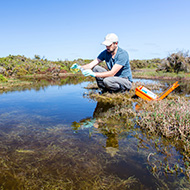London Zoo conducts annual weigh-in
Over 10,000 animals will be weighed for their health statistics.
The Zoological Society of London (ZSL) has been weighing more than 10,000 animals as it records the health statistics of London Zoo’s residents.
Statistics from the annual weigh-in will be used to update the keepers’ information and inform the animals’ future care. The data will also be stored on the Zoological Information Management System (ZIMS) so that zookeepers around the world can compare information about Threatened, Endangered and Critically Endangered species.
Statistics from the annual weigh-in will be used to update the keepers’ information and inform the animals’ future care. The data will also be stored on the Zoological Information Management System (ZIMS) so that zookeepers around the world can compare information about Threatened, Endangered and Critically Endangered species.
Camel keeper Mick Tiley weighs Noemie the Bactrian camel.
Among those being weighed were the zoo’s Bactrian camels, Genghis and Noemie. Zookeeper Mick Tiley was able to gently encourage them to step onto a giant weighboard.
At approximately 682kg each, Genghis and Noemie are among the zoo’s heaviest animals.
At approximately 682kg each, Genghis and Noemie are among the zoo’s heaviest animals.
Penguin keeper Jessica Ray notes the weight of each Humboldt penguin.
Ten Humboldt penguin chicks, which were born in spring this year, were also lined up to be weighed. London Zoo is home to over 60 of this Vulnerable species
The chicks did not need much encouragement and were happy to hop onto the scales in return for a bucket of fish. Humboldt penguin Swiftie weighed 4.42kg.
The chicks did not need much encouragement and were happy to hop onto the scales in return for a bucket of fish. Humboldt penguin Swiftie weighed 4.42kg.
Mali, Syanii and Shanti investigate their latest measurements.
It was also the first weigh-in for London Zoo’s three Endangered Asiatic lion cubs which were born at the zoo on 13 March 2024.
The trio, named Mali, Syanii and Shanti, are weighed regularly by the zookeepers to monitor their growth and development. For this weigh-in, the cubs were given a scented board of their latest measurements to investigate.
Male cubs Mali and Syanii weighed 18kg and 17kg respectively, while their sister Shanti weighed in at 15kg.
Angela Ryan, London Zoo’s head of zoological operations, said: “We regularly record the vital statistics of every animal at the zoo, from the tallest giraffe to the small White tree frogs in our new Secret Life of Reptiles and Amphibians habitat.
“This allows us to make sure that all the animals under our care are healthy, eating properly, and developing at the appropriate rate. For some species, weighing is the only way to detect and track a pregnancy, which is especially crucial for the many endangered animals at London Zoo that are involved in global conservation breeding efforts.”
The trio, named Mali, Syanii and Shanti, are weighed regularly by the zookeepers to monitor their growth and development. For this weigh-in, the cubs were given a scented board of their latest measurements to investigate.
Male cubs Mali and Syanii weighed 18kg and 17kg respectively, while their sister Shanti weighed in at 15kg.
Angela Ryan, London Zoo’s head of zoological operations, said: “We regularly record the vital statistics of every animal at the zoo, from the tallest giraffe to the small White tree frogs in our new Secret Life of Reptiles and Amphibians habitat.
“This allows us to make sure that all the animals under our care are healthy, eating properly, and developing at the appropriate rate. For some species, weighing is the only way to detect and track a pregnancy, which is especially crucial for the many endangered animals at London Zoo that are involved in global conservation breeding efforts.”
Images © London Zoo



 A set of international guidelines for disease surveillance in wildlife has been updated for the first time since 2015.
A set of international guidelines for disease surveillance in wildlife has been updated for the first time since 2015.